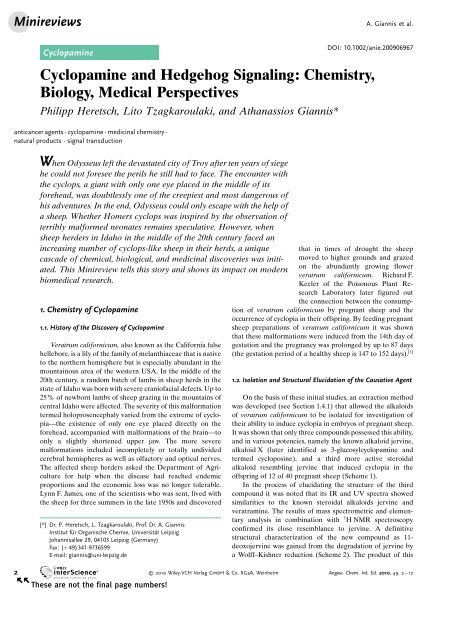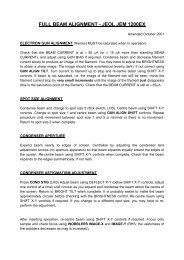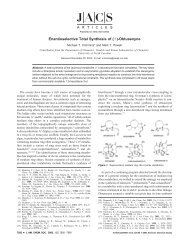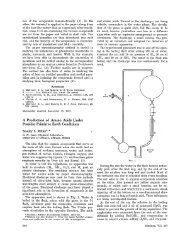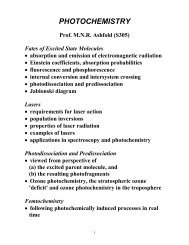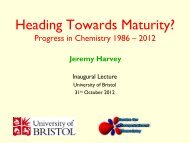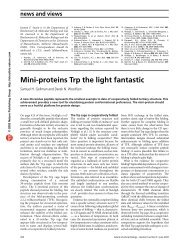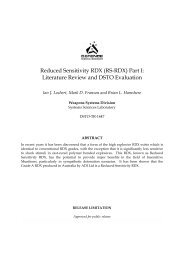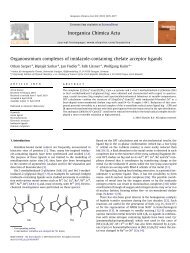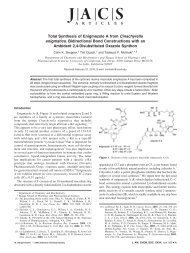Cyclopamine and Hedgehog Signaling: Chemistry, Biology, Medical ...
Cyclopamine and Hedgehog Signaling: Chemistry, Biology, Medical ...
Cyclopamine and Hedgehog Signaling: Chemistry, Biology, Medical ...
Create successful ePaper yourself
Turn your PDF publications into a flip-book with our unique Google optimized e-Paper software.
Minireviews<br />
<strong>Cyclopamine</strong><br />
DOI: 10.1002/anie.200906967<br />
<strong>Cyclopamine</strong> <strong>and</strong> <strong>Hedgehog</strong> <strong>Signaling</strong>: <strong>Chemistry</strong>,<br />
<strong>Biology</strong>, <strong>Medical</strong> Perspectives<br />
Philipp Heretsch, Lito Tzagkaroulaki, <strong>and</strong> Athanassios Giannis*<br />
anticancer agents · cyclopamine · medicinal chemistry ·<br />
natural products · signal transduction<br />
When Odysseus left the devastated city of Troy after ten years of siege<br />
he could not foresee the perils he still had to face. The encounter with<br />
the cyclops, a giant with only one eye placed in the middle of its<br />
forehead, was doubtlessly one of the creepiest <strong>and</strong> most dangerous of<br />
his adventures. In the end, Odysseus could only escape with the help of<br />
a sheep. Whether Homers cyclops was inspired by the observation of<br />
terribly malformed neonates remains speculative. However, when<br />
sheep herders in Idaho in the middle of the 20th century faced an<br />
increasing number of cyclops-like sheep in their herds, a unique<br />
cascade of chemical, biological, <strong>and</strong> medicinal discoveries was initiated.<br />
This Minireview tells this story <strong>and</strong> shows its impact on modern<br />
biomedical research.<br />
1. <strong>Chemistry</strong> of <strong>Cyclopamine</strong><br />
1.1. History of the Discovery of <strong>Cyclopamine</strong><br />
Veratrum californicum, also known as the California false<br />
hellebore, is a lily of the family of melanthiaceae that is native<br />
to the northern hemisphere but is especially abundant in the<br />
mountainous area of the western USA. In the middle of the<br />
20th century, a r<strong>and</strong>om batch of lambs in sheep herds in the<br />
state of Idaho was born with severe craniofacial defects. Up to<br />
25% of newborn lambs of sheep grazing in the mountains of<br />
central Idaho were affected. The severity of this malformation<br />
termed holoprosencephaly varied from the extreme of cyclopia—the<br />
existence of only one eye placed directly on the<br />
forehead, accompanied with malformations of the brain—to<br />
only a slightly shortened upper jaw. The more severe<br />
malformations included incompletely or totally undivided<br />
cerebral hemispheres as well as olfactory <strong>and</strong> optical nerves.<br />
The affected sheep herders asked the Department of Agriculture<br />
for help when the disease had reached endemic<br />
proportions <strong>and</strong> the economic loss was no longer tolerable.<br />
Lynn F. James, one of the scientists who was sent, lived with<br />
the sheep for three summers in the late 1950s <strong>and</strong> discovered<br />
[*] Dr. P. Heretsch, L. Tzagkaroulaki, Prof. Dr. A. Giannis<br />
Institut für Organische Chemie, Universität Leipzig<br />
Johannisallee 29, 04103 Leipzig (Germany)<br />
Fax: (+ 49)341-9736599<br />
E-mail: giannis@uni-leipzig.de<br />
A. Giannis et al.<br />
that in times of drought the sheep<br />
moved to higher grounds <strong>and</strong> grazed<br />
on the abundantly growing flower<br />
veratrum californicum. Richard F.<br />
Keeler of the Poisonous Plant Research<br />
Laboratory later figured out<br />
the connection between the consumption<br />
of veratrum californicum by pregnant sheep <strong>and</strong> the<br />
occurrence of cyclopia in their offspring. By feeding pregnant<br />
sheep preparations of veratrum californicum it was shown<br />
that these malformations were induced from the 14th day of<br />
gestation <strong>and</strong> the pregnancy was prolonged by up to 87 days<br />
(the gestation period of a healthy sheep is 147 to 152 days). [1]<br />
1.2. Isolation <strong>and</strong> Structural Elucidation of the Causative Agent<br />
On the basis of these initial studies, an extraction method<br />
was developed (see Section 1.4.1) that allowed the alkaloids<br />
of veratrum californicum to be isolated for investigation of<br />
their ability to induce cyclopia in embryos of pregnant sheep.<br />
It was shown that only three compounds possessed this ability,<br />
<strong>and</strong> in various potencies, namely the known alkaloid jervine,<br />
alkaloid X (later identified as 3-glucosylcyclopamine <strong>and</strong><br />
termed cycloposine), <strong>and</strong> a third more active steroidal<br />
alkaloid resembling jervine that induced cyclopia in the<br />
offspring of 12 of 40 pregnant sheep (Scheme 1).<br />
In the process of elucidating the structure of the third<br />
compound it was noted that its IR <strong>and</strong> UV spectra showed<br />
similarities to the known steroidal alkaloids jervine <strong>and</strong><br />
veratramine. The results of mass spectrometric <strong>and</strong> elementary<br />
analysis in combination with 1 H NMR spectroscopy<br />
confirmed its close resemblance to jervine. A definitive<br />
structural characterization of the new compound as 11deoxojervine<br />
was gained from the degradation of jervine by<br />
a Wolff–Kishner reduction (Scheme 2). The product of this<br />
2 2010 Wiley-VCH Verlag GmbH & Co. KGaA, Weinheim Angew. Chem. Int. Ed. 2010, 49, 2–12<br />
Ü<br />
Ü<br />
These are not the final page numbers!
<strong>Cyclopamine</strong><br />
Scheme 1. Structures of veratramine, jervine, <strong>and</strong> cycloposine.<br />
Scheme 2. Wolff–Kishner reduction of jervine.<br />
transformation was identical in every respect to the newly<br />
isolated steroidal alkaloid. In accordance with the epic by<br />
Homer about the odyssey in which the encounter of Odysseus<br />
with the cyclops Polyphemus is described, Keeler named this<br />
new natural product cyclopamine. [2]<br />
<strong>Cyclopamine</strong> consists of a hexacyclic framework of four<br />
annulated carbocycles, three of them are six-membered rings<br />
(A, B, <strong>and</strong> D ring) <strong>and</strong> one is a five-membered ring (C ring).<br />
A highly substituted tetrahydrofuran forms ring E, which is<br />
spiro-connnected to ring D. A piperidine ring with a secondary<br />
basic nitrogen atom forms ring F, which is annulated to<br />
ring E (Scheme 3). <strong>Cyclopamine</strong> is a so-called isosteroid (“6-<br />
6-5-6-system”). The molecular structure bears an inherent<br />
Scheme 3. Structure of cyclopamine with ring <strong>and</strong> carbon numbering.<br />
instability that arises from the C12 C13 double bond, which<br />
renders the furan oxygen atom allylic. Treatment of cyclopamine<br />
with Lewis acids or at pH < 2 leads to cleavage of the<br />
spiro connection of this oxygen atom to ring D. This ring<br />
aromatizes to form the toxic veratramine that no longer has<br />
any of the teratogenic effects of cyclopamine. [1] Only a small<br />
proportion of cyclopamine in veratrum californicum is<br />
structurally unaffected after ingestion <strong>and</strong> passage through<br />
the stomach, but this amount is sufficient to cause the<br />
malformations described.<br />
Although a change in the grazing habits helped to<br />
eliminate the cases of cyclopia in the herds immediately, the<br />
molecular biological background <strong>and</strong> mechanism of this<br />
curious molecule remained unknown for another 25 years.<br />
1.3. Biosynthesis of <strong>Cyclopamine</strong><br />
Angew<strong>and</strong>te<br />
Chemie<br />
Philipp Heretsch was born in Lippstadt in<br />
1982. He studied chemistry at the University<br />
of Leipzig <strong>and</strong> recently completed his<br />
PhD with Athanassios Giannis on the synthesis<br />
of cyclopamine. During his studies<br />
<strong>and</strong> his PhD research he was a fellow of the<br />
Fonds der Chemischen Industrie. In 2008 he<br />
was awarded the Procter&Gamble-Förderpreis.<br />
From summer 2010 he will be a<br />
postdoctoral associate with K. C. Nicolaou.<br />
Lito Tzagkaroulaki was born in Greece in<br />
1983. From 2001 to 2008 she studied<br />
medicine at the University of Athens. Since<br />
2008 she has been conducting PhD research<br />
with Athanassios Giannis on the investigation<br />
of receptor tyrosine kinase inhibitors<br />
<strong>and</strong> modulators of hedgehog signaling.<br />
Athanassios Giannis is a chemist <strong>and</strong> physician.<br />
He was born in Greece in 1954 <strong>and</strong><br />
studied chemistry from 1972 to 1980 <strong>and</strong><br />
medicine from 1978 to 1987 at the University<br />
of Bonn. He completed his PhD in<br />
1986 with Konrad S<strong>and</strong>hoff <strong>and</strong> habilitiated<br />
in 1992 at the University of Bonn in organic<br />
chemistry <strong>and</strong> biochemistry. From 1998 to<br />
2002 he was an associate professor at the<br />
University of Karlsruhe. Since 2002 he has<br />
been full professor for organic chemistry <strong>and</strong><br />
natural products chemistry at the University<br />
of Leipzig. His area of research is biological<strong>and</strong><br />
medicinal-oriented organic chemistry.<br />
Veratrum plants contain five types of steroidal alkaloids:<br />
the solanidine alkaloids (for example, solanidine, rubijervine,<br />
<strong>and</strong> epirubijervine) <strong>and</strong> verazine alkaloids (for example,<br />
verazine <strong>and</strong> etioline), which all possess a steroid skeleton of<br />
the classical (“6-6-6-5”) type, the veratramine alkaloids (for<br />
example, veratramine), the jervine alkaloids (for example,<br />
jervine <strong>and</strong> cyclopamine), <strong>and</strong> the cevanine alkaloids that all<br />
possess a C-nor-D-homosteroid skeleton. The work of<br />
Tschesche <strong>and</strong> Kaneko [3] in the 1960s <strong>and</strong> 1970s on veratrum<br />
gr<strong>and</strong>iflorum allowed elucidation of the biosynthetic origin of<br />
cyclopamine <strong>and</strong> other veratrum alkaloids, <strong>and</strong> through<br />
Angew. Chem. Int. Ed. 2010, 49, 2 – 12 2010 Wiley-VCH Verlag GmbH & Co. KGaA, Weinheim www.angew<strong>and</strong>te.org<br />
These are not the final page numbers! Ü Ü<br />
3
Minireviews<br />
studies with 14 C-labeled cholesterol <strong>and</strong> acetate allowed<br />
identification of cholesterol as a common precursor. Cholesterol<br />
is transformed in the plant through a number of<br />
reactions (some have only been assumed) into the parent<br />
compound of this class of natural products: solanidine. In a<br />
series of oxidative <strong>and</strong> reductive processes, first the piperidine<br />
is synthesized <strong>and</strong> then the E ring of solanidine is formed in a<br />
reaction driven by adenosine triphosphate (ATP). A stereounspecific<br />
oxidase subsequently hydroxylates at the C12position<br />
to form the 12a-hydroxy product (rubijervine), which<br />
is enriched in the rhizomes, <strong>and</strong> the 12b-hydroxy product<br />
(epirubijervine). Only the hydroxy group of the latter<br />
compound is converted into a phosphate leaving group <strong>and</strong><br />
rearranges through a Wagner–Meerwein type reaction into<br />
the C-nor-D-homosteroid skeleton. The necessity of light for<br />
this process was discussed. Reductive opening of the pyrollidine<br />
ring (E ring) gives husokinidine, which is finally oxidatively<br />
cyclized to form the tetrahydrofuran ring of cyclopamine<br />
(Scheme 4). Studies with 14 C-labeled cyclopamine<br />
showed that both jervine <strong>and</strong> veratramine are biosynthesized<br />
from cyclopamine. [3]<br />
Scheme 4. Biosynthesis of cyclopamine from cholesterol in veratrum<br />
gr<strong>and</strong>iflorum.<br />
1.4. Accessibility of <strong>Cyclopamine</strong><br />
“However, we believe that with this study, the evidence is in<br />
place to justify an effort to develop a supply [of cyclopamine]<br />
so that it can be tested in humans.” In this way Philip A.<br />
Beachy commented in 2002 in an interview at the Howard<br />
Hughes <strong>Medical</strong> Institute on the necessity of making available<br />
larger amounts of cyclopamine at affordable prices.<br />
In principle there are two ways to fulfill this task: the<br />
development of reliable extraction processes of cyclopamine<br />
from veratrum californicum, <strong>and</strong> the development of a<br />
synthetic route. Both approaches have been studied since<br />
the 1960s, but only recently were both a modern extraction<br />
process <strong>and</strong> a chemical synthesis reported that meet the<br />
requirements in terms of efficiency, economy, <strong>and</strong> feasibility.<br />
1.4.1. Extraction from Veratrum californicum<br />
Keeler’s early attempts at extraction were on dried <strong>and</strong><br />
ground roots <strong>and</strong> rhizomes of veratrum californicum. This<br />
material was steeped in aqueous ammonia <strong>and</strong> extracted<br />
repeatedly with benzene. After removal of the solvent, the<br />
crystalline fraction was purified repeatedly by chromatography<br />
<strong>and</strong> recrystallization to yield the pure alkaloids cyclopamine<br />
<strong>and</strong> veratramine. This process afforded a yield of<br />
320 mg of cyclopamine per kg of dried roots. [2]<br />
Recently, Cooper achieved a noticeable increase in the<br />
yield of this process by treating dried <strong>and</strong> ground roots first<br />
with aqueous ammonia, <strong>and</strong> then isolated the alkaloids by<br />
Soxhlet extraction (benzene as solvent). After removal of the<br />
solvent <strong>and</strong> two purifications by chromatography, cyclopamine<br />
was precipitated in acetone <strong>and</strong> recrystallized twice<br />
from ethanol/water to yield an average of 1.3 g of pure<br />
cyclopamine per kg of dried plants. Since dried roots of<br />
veratrum californicum contain about 2.34 g of cyclopamine<br />
per kg, this process has a yield of 55% <strong>and</strong>, therefore, can be<br />
regarded as efficient. However, problems arise from the<br />
extensive use of benzene (decaliter scale), especially when it<br />
comes to extracting large amounts of cyclopamine. [4]<br />
1.4.2. Synthetic Access<br />
A. Giannis et al.<br />
In the 1960s the research groups of Masamune <strong>and</strong><br />
Johnson published the first total synthesis of jervine, <strong>and</strong> the<br />
research group of Kutney followed in the 1970s with an<br />
improved synthesis of an advanced intermediate of the<br />
original route. [5,6] Since it had been demonstrated previously<br />
that jervine could be transformed into cyclopamine in one<br />
step <strong>and</strong> in moderate yield by a Wolff–Kishner reduction,<br />
these two syntheses also constitute the first formal route to<br />
cyclopamine. Our research group recently achieved a direct<br />
synthetic route to cyclopamine starting from commercially<br />
available dehydroepi<strong>and</strong>rosterone. [7]<br />
The research groups of Masamune <strong>and</strong> Johnson established<br />
a convergent access to jervine starting from the<br />
Hagemann ester—as a precursor of the C-nor-D-homosteroid—as<br />
well as (3S)-methylpiperidine—as a progenitor of<br />
the alkaloid substructure. The C-nor-D-homosteroid was first<br />
synthesized from the Hagemann ester in a racemic fashion by<br />
4 www.angew<strong>and</strong>te.org 2010 Wiley-VCH Verlag GmbH & Co. KGaA, Weinheim Angew. Chem. Int. Ed. 2010, 49, 2–12<br />
Ü<br />
Ü<br />
These are not the final page numbers!
<strong>Cyclopamine</strong><br />
using the Wilds–Stoutamire reaction, two Robinson annulations,<br />
as well as several redox operations. This racemic<br />
material was then resolved. The optically pure steroid was<br />
shown to be identical with material obtained in larger<br />
amounts by the known degradation <strong>and</strong> rearrangement of<br />
hecogenine. The crucial step in the synthesis was a coupling<br />
with an alkaloid precursor. Thus, enamine 2 was coupled with<br />
bromide 1. This reaction did not proceed diastereoselectively,<br />
with the desired diastereoisomer isolated in only 5% yield.<br />
The so obtained veratramine derivative 3 was then transformed,<br />
by manipulations of the oxidation state, into the<br />
epoxide 4, which was then opened by intramolecular nucleophilic<br />
attack of the secondary alcoholate at the C23-position.<br />
Further manipulation of the oxidation state finally yielded<br />
jervine (Scheme 5). [5]<br />
In summary, this first synthesis of cyclopamine illustrates<br />
the challenges such an endeavor poses: a convergent strategy<br />
heavily relies on an efficient <strong>and</strong> diastereoselective coupling<br />
method. This task was not addressed satisfactorily by the<br />
authors: the total yield of this synthesis starting from 1 is only<br />
about 0.001% (estimation based on incompletely reported<br />
data). This result cannot meet modern requirements in terms<br />
of efficiency, elegance, <strong>and</strong> economy, but nevertheless represents<br />
an achievement when the limited possibilities available<br />
at that time are considered.<br />
The formal synthesis by Kutney et al. in the 1970s<br />
generates an advanced intermediate of the Masamune/<br />
Johnson route. Again, the coupling of a lithiated picoline<br />
with a C-nor-D-homosteroid enone in a convergent fashion<br />
gives a coupling product in much better yield (62 %) than the<br />
original procedure, although as a mixture of C20 epimers.<br />
Since the subsequent hydrogenation of the pyridine nucleus<br />
to the corresponding piperidine provides (besides other<br />
isomers) the correct stereoisomer in 18% yield, the yield of<br />
the first procedure was improved. [6] Since the further elaboration<br />
resembles the Masamune/Johnson route, only the<br />
crucial fragment coupling was new, <strong>and</strong> thus the route was<br />
neither shorter nor much more efficient.<br />
Scheme 5. Synthesis of jervine by the research groups of Masamune <strong>and</strong> Johnson.<br />
Angew<strong>and</strong>te<br />
Chemie<br />
Our research group recently accomplished a biomimetic<br />
<strong>and</strong> completely diastereoselective synthetic route to cyclopamine<br />
which did not involve jervine as an intermediate. This<br />
route initially creates a 12b-hydroxy steroid from commercially<br />
available dehydroepi<strong>and</strong>rosterone in three steps by a<br />
C H activation <strong>and</strong> oxidation with molecular oxygen. This<br />
material is then transformed in four more steps into the<br />
lactone 5. A subsequent Wagner–Meerwein rearrangement<br />
gives rise to the C-nor-D-homosteroid system in which the<br />
lactone is then a-azidized. The synthesis commences with the<br />
construction of the piperidine ring in seven steps to yield the<br />
cyclopamine derivative 7 with an exocyclic double bond. The<br />
decisive transformation is a t<strong>and</strong>em Horner–Wadsworth–<br />
Emmons (HWE) <strong>and</strong> intramolecular Michael reaction. The<br />
final isomerization of the double bond to the C12 C13position<br />
is achieved using an Alder–ene reaction with Nsulfinylbenzene<br />
sulfonamide <strong>and</strong> subsequent desulfurization.<br />
Deprotection affords cyclopamine in 20 steps <strong>and</strong> a total yield<br />
of 1% (Scheme 6).<br />
This strategy uses the presumed biosynthetic concept for<br />
the creation of the C-nor-D-homosteroid skeleton by C H<br />
activation/oxidation at the 12b-position <strong>and</strong> ring contraction/<br />
expansion by conversion of this alcohol function into a leaving<br />
group. Thus, it can be regarded as biomimetic. [7] Furthermore,<br />
the problem of unsatisfactory selectivity in the fragment<br />
coupling is circumvented by this linear approach. All<br />
reactions proceed under substrate control: the use of chiral<br />
auxiliaries <strong>and</strong> catalysts is therefore rendered unnecessary.<br />
This route also provides access to cyclopamine derivatives<br />
with different configurations, thus making it possible to<br />
establish fundamental structure–activity relationships. The<br />
potential of cyclopamine derivatives with an exocyclic double<br />
bond will be emphasized in particular, since these derivatives<br />
may exhibit enhanced metabolic stability <strong>and</strong> not degrade<br />
into toxic veratramine through aromatization of the D ring.<br />
Our research group also recently published a synthetic<br />
strategy to all diastereoisomers of the piperidine alkaloid<br />
substructure of cyclopamine <strong>and</strong> all other veratrum alkaloids.<br />
[8] For example, a correctly substituted piperidine lactone<br />
Angew. Chem. Int. Ed. 2010, 49, 2 – 12 2010 Wiley-VCH Verlag GmbH & Co. KGaA, Weinheim www.angew<strong>and</strong>te.org<br />
These are not the final page numbers! Ü Ü<br />
5
Minireviews<br />
Scheme 6. Biomimetic synthesis of cyclopamine by Giannis et al.<br />
Bn = benzyl, Bs = benzenesulfonyl.<br />
such as 9 is synthesized in nine steps <strong>and</strong> in optically pure<br />
form with a substitution pattern that enables fragment<br />
coupling (Scheme 7). Since this synthetic route proceeds in<br />
a total yield of 42% starting from citronellic acid, it seems<br />
well suited for a new convergent approach towards cyclopamine.<br />
Scheme 7. Synthesis of the piperidine alkaloid substructure of cyclopamine.<br />
Cbz = benzyloxycarbonyl.<br />
1.5. Derivatives of <strong>Cyclopamine</strong><br />
The improved commercial availability of cyclopamine<br />
from plant material through higher yielding extraction<br />
methods (see Section 1.4.1) has resulted in an increase in<br />
the number of semisynthetic cyclopamine derivatives. The<br />
price of cyclopamine has dropped by a factor of 50, in recent<br />
years <strong>and</strong> multigram amounts have become available. All the<br />
cyclopamine-like structures synthesized to date are semisynthetic<br />
derivatives, that is, derivatives synthesized from<br />
natural cyclopamine by chemical modification of the natural<br />
product. Since there is no facile synthetic approach (total<br />
synthesis) to cyclopamine, there are currently no completely<br />
synthetic cyclopamine derivatives.<br />
KAAD-cyclopamine (Scheme 8), the first derivative that<br />
exhibited better solubility <strong>and</strong> an increased biological potency<br />
by a factor of 10 to 20, was obtained in five steps from natural<br />
cyclopamine. [9] To what extent the nonconjugated double<br />
Scheme 8. Structure of KAAD-cyclopamine.<br />
bond in the C5 C6-position is transformed to the corresponding<br />
enone under physiological conditions remains<br />
unexplored.<br />
Infinity Pharmaceuticals published a multistep approach<br />
to D-homocyclopamine derivatives, that is, derivatives with a<br />
seven-membered D ring (Scheme 9). These derivatives do not<br />
Scheme 9. D-ring expansion of cyclopamine derivatives.<br />
A. Giannis et al.<br />
inherit the instability of cyclopamine, since aromatization by<br />
cleavage of the allyl ether system cannot occur. Several<br />
derivatives of this type have been synthesized <strong>and</strong> patented,<br />
<strong>and</strong> their biological profiles have been determined—some of<br />
them are shown in Scheme 10. [10] Carbohydrate–cyclopamine<br />
Scheme 10. Structure of some D-homo-ring derivatives of cyclopamine.<br />
6 www.angew<strong>and</strong>te.org 2010 Wiley-VCH Verlag GmbH & Co. KGaA, Weinheim Angew. Chem. Int. Ed. 2010, 49, 2–12<br />
Ü<br />
Ü<br />
These are not the final page numbers!
<strong>Cyclopamine</strong><br />
conjugates were prepared by using the concepts of click<br />
chemistry. [11]<br />
A simplified cyclopamine analogue was prepared from<br />
estrone in four steps by Winkler et al. The C-nor-D-homosteroid<br />
structure was omitted in favor of a conventional<br />
steroid system, a pyridine was used in place of the piperidine<br />
ring, <strong>and</strong> a phenol used for the homoallyl alcohol. Although<br />
these modifications have great influence on the structure,<br />
polarity, <strong>and</strong> acidity, biological activity was still evident. [12]<br />
The omission of the final isomerization of the double bond<br />
by an Alder–ene reaction, as used in the synthesis of<br />
cyclopamine established by our research group, [7] would yield<br />
a cyclopamine derivative with an exocyclic double bond. Our<br />
synthetic strategy also allows the flexible introduction of<br />
methyl groups 21 <strong>and</strong> 27 with different configurations. It also<br />
allows variation of the configuration of the N-substituted<br />
center at C22, the preparation of derivatives without these<br />
methyl groups, different sizes of the F ring, <strong>and</strong> different<br />
heteroatoms in ring E. Thus, multiple analogues of cyclopamine<br />
could become available <strong>and</strong> would allow fundamental<br />
insights into structure–activity relationships from their biological<br />
potencies (Scheme 11)<br />
Scheme 11. Possible variations in the synthesis of cyclopamine by<br />
Giannis et al.<br />
2. <strong>Biology</strong> of <strong>Cyclopamine</strong><br />
In the late 1970s Nüsslein-Volhard <strong>and</strong> Wieschaus at the<br />
European Molecular <strong>Biology</strong> Laboratory in Heidelberg<br />
studied mutations in the fruit fly Drosophila melanogaster<br />
<strong>and</strong> identified more than 50 different genes that have a direct<br />
effect on embryonic development. One of these genes caused<br />
the larvae to grow a coat of spines on their undersides when it<br />
was mutated. The similarity of these larvae with a hedgehog<br />
led to the term hedgehog gene (hh). Christiane Nüsslein-<br />
Volhard <strong>and</strong> Eric F. Wieschaus together with Edward B.<br />
Lewis were awarded the Nobel prize in medicine in 1995<br />
for their l<strong>and</strong>mark research in the field of genetics of early<br />
embryonic development. [13]<br />
The hedgehog gene encodes for three unique proteins:<br />
Shh (Sonic hedgehog), Ihh (Indian hedgehog), und Dhh<br />
(Desert hedgehog). All of them are lig<strong>and</strong>s of the membranebound<br />
receptor Patched (a 12-transmembrane protein) <strong>and</strong><br />
activate the hedgehog signaling pathway, that is, they have an<br />
indirect influence on the transcription of hedgehog-response<br />
genes. The hedgehog signaling pathway consists of a cascade<br />
of repressive interactions. In the absence of a hh lig<strong>and</strong>, the<br />
Angew<strong>and</strong>te<br />
Chemie<br />
membrane-bound protein Patched1 (Ptch1) is found at the<br />
base of the primary cilia near the centrosome. Cilia are taillike<br />
projections of the cell membrane that can be found in a<br />
single copy on nearly every eukaryotic cell. They are involved<br />
in sensing mechanical <strong>and</strong> chemical signals <strong>and</strong> act as<br />
communication hubs for signaling that controls cell differentiation<br />
<strong>and</strong> polarity. Ptch1 inhibits at the base of the<br />
primary cilium the translocation of the membrane-bound<br />
receptor Smoothened (Smo; a 7-transmembrane protein)<br />
from intracellular compartments to the cilium by an unknown<br />
mechanism. Thus, SuFu (the suppressor of the protein Fused),<br />
a negative regulator of hh signaling, stays active, which<br />
eventually leads to proteosomal cleavage <strong>and</strong> transformation<br />
of transcription factors Gli2 <strong>and</strong> Gli3 into their repressor<br />
forms. These Gli2/3R factors repress transcription of hedgehog-response<br />
genes. Many of these interactions are not well<br />
understood, although more recent studies show that translocation<br />
of Smo from endosomes into the ciliary membrane is<br />
inhibited by the influence of Ptch1 on the lipid composition of<br />
these compartments. [14a]<br />
The binding of a hh lig<strong>and</strong> results in the Ptch1 translocation<br />
out of the primary cilium <strong>and</strong> its degradation by<br />
lyosomes. Smo now moves into the cilium, thus stimulating<br />
the pathway <strong>and</strong> preventing cleavage of Gli2 <strong>and</strong> Gli3.<br />
Activated Gli2 (<strong>and</strong> to a lesser extent Gli3) then bind to Gli<br />
promoters in the nucleus <strong>and</strong> stimulate the transcription of<br />
hedgehog-response genes. [14]<br />
The hedgehog gene is now regarded as a key regulator of<br />
embryonic development <strong>and</strong> is highly conserved from fruit<br />
flies to humans. In insects, hedgehog signaling controls the<br />
correct segmentation <strong>and</strong> the development of the wings. The<br />
existence of the Shh gene in mammals was reported by Tabin<br />
<strong>and</strong> co-workers in 1993. [15a] In mammals, it induces bilateral<br />
symmetry <strong>and</strong> the correct formation of limbs, skeleton,<br />
muscles, skin, eyes, lungs, teeth, nervous system, <strong>and</strong> intestines<br />
as well as the differentiation of sperm <strong>and</strong> cartilage.<br />
During their studies on hedgehog signaling, Beachy <strong>and</strong><br />
co-workers searched for a simple way to control this pathway<br />
that did not involve gene knockout—a task that is difficult<br />
<strong>and</strong> lengthy to perform. The use of small molecules as<br />
biochemical probes offered an easier <strong>and</strong> faster alternative.<br />
However, a molecule that was able to influence hedgehog<br />
signaling was not known at that time.<br />
Beachy <strong>and</strong> co-workers succeeded in combining their<br />
knowledge on two seemingly different scientific fields to solve<br />
this problem: the events in Idaho in the 1950s had remained a<br />
footnote in the history of science. It was, however, known that<br />
holoprosencephaly could be observed in severe cases of<br />
Smith–Lemli–Opitz syndrome (a defect in cholesterol biosynthesis<br />
caused by a deficiency of 7-dehydrocholesterol<br />
reductase). At first, Beachy <strong>and</strong> co-workers suspected cyclopamine<br />
to be an inhibitor of cholesterol biosynthesis (an idea<br />
further supported by the structural similarities of these<br />
molecules). However, this assumption was shown to be<br />
incorrect. In 1998, Beachy <strong>and</strong> co-workers finally identified<br />
that cyclopamine interacts with the protein Smo of the hhsignaling<br />
pathway, thereby inhibiting the activity of this<br />
pathway even when an hh lig<strong>and</strong> is present. <strong>Cyclopamine</strong><br />
binds to Smo <strong>and</strong> inhibits its activity by a conformational<br />
Angew. Chem. Int. Ed. 2010, 49, 2 – 12 2010 Wiley-VCH Verlag GmbH & Co. KGaA, Weinheim www.angew<strong>and</strong>te.org<br />
These are not the final page numbers! Ü Ü<br />
7
Minireviews<br />
change. However, a general dependence of the hh signaling<br />
on cholesterol <strong>and</strong> its metabolites exists because of the<br />
necessity of C-terminal cholesteroylation of the hh lig<strong>and</strong> in<br />
its maturation process (additionally the hh protein is palmitoylated<br />
at the N terminus; Figure 1). [15]<br />
Figure 1. The hedgehog signaling pathway. A) In the absence of hh<br />
lig<strong>and</strong>s, Ptch1 inhibits Smo from entering the cilium; thus, SuFu stays<br />
active, the Gli2/3 transcription factors are cleaved by proteosomes,<br />
<strong>and</strong> transcription of hh-target genes is prevented. B) The binding of a<br />
hh lig<strong>and</strong> results in Ptch1 being inhibited <strong>and</strong> Smo moves into the<br />
cilium, where SuFu is inhibited <strong>and</strong> the active form of the Gli2/3<br />
factors can activate transcription of the hh gene in the nucleus;<br />
cyclopamine inhibits the activity of Smo <strong>and</strong> leads to deactivation of<br />
the hh path. For further explanation, see the text; scheme modified<br />
from Ref. [14b].<br />
When pregnant sheep ingest cyclopamine, embryonic<br />
development is critically disturbed since it heavily relies on hh<br />
signaling at several stages (for example, at the 14th day of<br />
gestation), which finally results in the malformations observed<br />
in Idaho.<br />
3. <strong>Medical</strong> Relevance of <strong>Cyclopamine</strong> <strong>and</strong><br />
<strong>Hedgehog</strong> <strong>Signaling</strong><br />
The hedgehog pathway is essential in multiple developmental<br />
processes <strong>and</strong> in the regulation of stem-cell <strong>and</strong><br />
progenitor-cell proliferation <strong>and</strong> differentiation. Since aberrant<br />
activation of the hh pathway leads to malignancies,<br />
including basal cell carcinoma, medulloblastoma, rhabdomyosarcoma,<br />
prostate, pancreatic, colorectal, prostate, <strong>and</strong><br />
breast cancer, inhibition of hh signaling provides a route to<br />
novel anticancer therapies. <strong>Hedgehog</strong>-pathway inhibitors<br />
(HPI) proved to be effective in in vitro studies on cancer cell<br />
lines <strong>and</strong> in animal disease models. Importantly, the anticancer<br />
activity of such inhibitors was recently demonstrated<br />
in clinical trials. In this section, some basic principles of the<br />
participation of the hh pathway in cancer <strong>and</strong> the important<br />
developments in this field are presented. An exhaustive<br />
discussion is beyond the scope of this Minireview, <strong>and</strong> the<br />
interested reader is referred to several excellent reviews. [16]<br />
Finally, some preclinical <strong>and</strong> a few recently published results<br />
of clinical studies with Smo inhibitors used as anticancer drugs<br />
will be discussed.<br />
3.1. Models of Cancer involving <strong>Hedgehog</strong> <strong>Signaling</strong><br />
A. Giannis et al.<br />
Three basic models are discussed in the recent literature<br />
for the participation of the hh pathway in cancer (Figure 2) [17] :<br />
A) Type 1 cancers (lig<strong>and</strong> independent, mutation driven)<br />
were discovered first. Patients with Gorlin syndrome,<br />
which belongs to this category, have a high incidence of<br />
Figure 2. Models for the development of cancer that involve hh signaling;<br />
cilia are not shown for reasons of clarity. For further explanation,<br />
see the text; scheme modified from Ref. [14b].<br />
basal cell carcinoma (BCC), medulloblastoma, <strong>and</strong><br />
rhabdomyosarcoma. The molecular basis for the development<br />
of this type of malignancies are inherited inactivating<br />
mutations in Ptch1 (through loss of heterozygosity<br />
<strong>and</strong>/or inactivating mutations), which lead to constitutively<br />
activated hh signaling in the absence of a lig<strong>and</strong>.<br />
Gorlin patients are excellent c<strong>and</strong>idates for therapy with<br />
inhibitors of Smo or downstream components of the hh<br />
pathway.<br />
B) Type 2 cancers are dependent on autocrine-secreted hh<br />
lig<strong>and</strong>s. The same tumor cells both produce the hh lig<strong>and</strong>s<br />
<strong>and</strong> responded to them. Only recently, it was demonstrated<br />
conclusively that this type of hh signaling exists in<br />
human cancer cell lines of the colon. [18]<br />
C) Type 3 cancers are dependent on paracrine-secreted hh<br />
lig<strong>and</strong>s. Recent studies showed that an overproduction of<br />
hh lig<strong>and</strong>s by the tumor cells occurs in most cancers<br />
linked to aberrant hh signaling. <strong>Hedgehog</strong> proteins may<br />
stimulate stromal cells near the tumor (endothelial cells,<br />
epithelial cells, fibroblasts, <strong>and</strong> immune cells). This results<br />
in an indirect support for tumor growth through mechanisms<br />
originating in the stromal cells. Such mechanisms<br />
8 www.angew<strong>and</strong>te.org 2010 Wiley-VCH Verlag GmbH & Co. KGaA, Weinheim Angew. Chem. Int. Ed. 2010, 49, 2–12<br />
Ü<br />
Ü<br />
These are not the final page numbers!
<strong>Cyclopamine</strong><br />
include the support of tumor cells, including tumor stem<br />
cells, stimulation of tumor angiogenesis, effects on the<br />
extracellular matrix, <strong>and</strong> secretion of components of the<br />
molecular signaling pathways involving insulin-like<br />
growth factor (IGF) <strong>and</strong> Wnt.<br />
D) A variant of this type of hh signaling is the so-called<br />
“reverse-paracrine” signaling (type 3b), where hh lig<strong>and</strong>s<br />
are secreted from stromal cells to receiving cells in a<br />
tumor.<br />
3.2. Treatment of Pancreas Cancer with <strong>Cyclopamine</strong> <strong>and</strong> its<br />
Derivatives<br />
More than 90 % of pancreatic cancers are ductal adenocarcinomas.<br />
They are the fourth most common cause of<br />
cancer-related mortality in both females <strong>and</strong> males in the<br />
USA. At metastatic stages, pancreatic cancer can almost<br />
never be controlled by any of the available drugs, <strong>and</strong> the fiveyear<br />
survival rate is estimated to be less than 2%. Even in<br />
cases with early stage, localized disease, where surgical<br />
resection with curative intention can be done, the majority<br />
of patients develop local recurrence or develop metastases in<br />
distant organs, <strong>and</strong> finally die. [19] Intensive efforts have been<br />
undertaken in recent years to develop therapeutic strategies<br />
that directly target the spread of metastatic tumors, <strong>and</strong> it is<br />
anticipated that such strategies will have tremendous clinical<br />
impact. Recently, a study involving global sequencing analysis<br />
identified the hh-signaling pathway as one of the “core”<br />
signaling pathways that undergoes somatic alterations in<br />
nearly all pancreatic cancers. [20] Inhibition of hh signaling with<br />
cyclopamine has enhanced the survival rate in a genetically<br />
engineered mouse model of pancreatic cancer <strong>and</strong> abrogated<br />
the systemic metastases arising from orthotopic xenografts. [21]<br />
This study also provides more evidence that hh signaling is a<br />
valid target for the development of novel therapeutics for<br />
pancreatic cancer <strong>and</strong> would be worth evaluating in a clinical<br />
setting.<br />
Since cyclopamine displays a low affinity for Smo, has<br />
poor oral bioavailability, suboptimal pharmacokinetics, <strong>and</strong><br />
low metabolic stability, the derivative IPI-269609<br />
(Scheme 10) was developed. It retains the potency of cyclopamine,<br />
but has improved physicochemical properties <strong>and</strong> is<br />
metabolically stable. IPI-269609 profoundly inhibited systemic<br />
metastases in orthotopic xenografts established from<br />
human pancreatic cancer cell lines. IPI-926 (Scheme 10), a<br />
novel semisynthetic cyclopamine analogue with substantially<br />
improved potency <strong>and</strong> a favorable pharmacokinetic profile<br />
relative to cyclopamine, was subsequently designed <strong>and</strong><br />
synthesized. By using a highly invasive <strong>and</strong> lethal genetically<br />
engineered model of pancreatic cancer, Olive et al. [22] showed<br />
that IPI-926 increases survival when used in combination with<br />
gemcitabine in this otherwise gemcitabine-resistant mouse<br />
model. This study clearly shows that inhibition of the hh<br />
pathway in the stroma of malignant tumors results in a<br />
striking reduction in the dense fibrotic reaction that accompanies<br />
these tumors. IPI-926 also increases tumor neovascularization,<br />
thereby facilitating the distribution of gemcitabine<br />
to malignant cells. This study suggests that patients with<br />
locally advanced pancreatic cancer are the most likely to<br />
benefit from a therapeutic inhibition of the hh pathway.<br />
3.3. A <strong>Hedgehog</strong>-Pathway Inhibitor for Treatment of Basal-Cell<br />
Carcinoma <strong>and</strong> Medulloblastoma<br />
Basal-cell carcinoma is the most common skin cancer in<br />
the USA <strong>and</strong> constitutes approximately 80 percent of all<br />
nonmelanoma skin cancers. The disease has an estimated<br />
annual incidence of 0.1 to 0.5% [23] <strong>and</strong> is largely caused by<br />
exposure to UV radiation. Surgery cures most cases of basalcell<br />
carcinoma, but in a few patients there is progression to<br />
life-threatening, inoperable, locally advanced, or metastatic<br />
tumors. For the reasons mentioned in Section 3.2, inhibitors<br />
of the hh pathway at the level of Smo represent valuable<br />
strategies for the treatment of this type of cancer. A cream<br />
containing cyclopamine was applied to basal-cell carcinoma<br />
in patients who were scheduled to have their tumors<br />
excised; [24] all of the tumors treated with cyclopamine<br />
regressed rapidly. Histological <strong>and</strong> immunohistochemical<br />
analyses showed inhibition of the proliferation <strong>and</strong> highly<br />
efficient induction of the differentiation <strong>and</strong> apoptosis of the<br />
tumor cells. The selective <strong>and</strong> highly efficient induction of the<br />
differentiation <strong>and</strong> apoptosis of tumor cells in vivo by<br />
transient inhibition of hh signaling provide a rational<br />
approach to treating BCC.<br />
Recently 33 patients with metastatic or locally advanced<br />
basal-cell carcinoma received GDC-0449 orally. GDC-0449 is<br />
an inhibitor (Scheme 12) of Smo, <strong>and</strong> structurally unrelated to<br />
Scheme 12. Structure of GDC-0449.<br />
Angew<strong>and</strong>te<br />
Chemie<br />
cyclopamine. [25] Of the 33 patients, 18 had an objective<br />
response to GDC-0449, <strong>and</strong> according to assessment by<br />
imaging <strong>and</strong>/or physical examination 11 patients showed a<br />
response. Of the patients who had a response, 2 had a<br />
complete response <strong>and</strong> 16 had a partial response. The other 15<br />
patients had either stable disease (11 patients) or progressive<br />
disease (4 patients). No dose-limiting toxic effects were<br />
observed during the study period. In conclusion, GDC-0449<br />
appears to have antitumor activity in locally advanced or<br />
metastatic basal-cell carcinoma. These findings also confirm<br />
the involvement of the hh pathway in basal-cell carcinoma<br />
<strong>and</strong> suggest that inhibition of this pathway could be useful to<br />
treat inoperable tumors.<br />
GDC-0449 has also been used in the therapy of medulloblastoma<br />
in one patient. [26] Medulloblastoma is the most<br />
common embryonal tumor in children. The median age at<br />
diagnosis is five years, with the age range extending into<br />
young adulthood. Therapy consists of surgical resection<br />
followed by radiation therapy <strong>and</strong> chemotherapy. Current<br />
Angew. Chem. Int. Ed. 2010, 49, 2 – 12 2010 Wiley-VCH Verlag GmbH & Co. KGaA, Weinheim www.angew<strong>and</strong>te.org<br />
These are not the final page numbers! Ü Ü<br />
9
Minireviews<br />
therapies have serious short-term <strong>and</strong> long-term adverse<br />
effects, including neurocognitive deficits, endocrinopathies,<br />
sterility, <strong>and</strong> the risk of secondary high-grade glioma or<br />
meningioma. [27] In the above-mentioned study, a 26-year-old<br />
man had metastatic medulloblastoma that was refractory to<br />
multiple therapies. Treatment with GDC-0449 resulted in a<br />
rapid but transient regression of the tumor <strong>and</strong> a dramatic<br />
reduction of the symptoms. Molecular analyses of tumor<br />
specimens obtained before treatment suggested that there<br />
was an activation of the hh pathway, with loss of heterozygosity<br />
<strong>and</strong> somatic mutation of the gene encoding Ptch1—a<br />
key negative regulator of hh signaling. The mutational status<br />
of hh-signaling genes in the tumor was determined after<br />
disease progression to evaluate the mechanism of resistance<br />
in the medulloblastoma patient. [28] The authors identified an<br />
amino acid substitution at a conserved aspartic acid residue of<br />
Smo that had no effect on hh signaling, but disrupted the<br />
ability of GDC-0449 to bind Smo <strong>and</strong> to act as an inhibitor of<br />
the hh pathway. A mutation altering the same amino acid also<br />
arose in a GDC-0449-resistant mouse model of medulloblastoma.<br />
These findings clearly show that acquired mutations in<br />
a serpentine receptor that has features of a G-protein-coupled<br />
receptor can serve as a mechanism of drug resistance in<br />
human cancer. Furthermore, the demonstration that these<br />
mutations do not have an impact on hh signaling continues to<br />
support the rationale for targeting this pathway, but also<br />
highlights the need to identify second-generation Smo<br />
inhibitors capable of overcoming acquired resistance <strong>and</strong> to<br />
identify inhibitors that target signaling molecules downstream<br />
of the Smo receptor. [29]<br />
Taken together, these clinical studies show that “the<br />
hedgehog pathway can be the basis of an important new class<br />
of therapeutic agents with far-reaching implications in<br />
oncology”. [30]<br />
4. Summary<br />
The story of cyclopamine began in 1957 with an unsettling<br />
observation <strong>and</strong> could possibly have ended as a footnote in<br />
the history of science after the problem was solved. Only the<br />
interdisciplinary interplay between chemistry, biology, <strong>and</strong><br />
medicine enabled cyclopamine to have a second coming. On<br />
the basis of the fundamental studies of Keeler <strong>and</strong> James as<br />
well as Nüsslein-Volhard <strong>and</strong> Wieschaus, Beachy was able to<br />
come to the final conclusion that initiated the development of<br />
cyclopamine as an anticancer therapeutic, the potential of<br />
which is only starting to be realized. This development has<br />
taken place over 50 years <strong>and</strong> can be regarded as a prime<br />
example of nonlinear research that rewards the persistent<br />
observer.<br />
Received: December 10, 2009<br />
Published online: && &&, 2010<br />
[1] a) R. F. Keeler, J. Agric. Food Chem. 1969, 17, 473 – 482; b) L. F.<br />
James, K. E. Panter, W. Gaffield, R. J. Molyneux, J. Agric. Food<br />
Chem. 2004, 52, 3211 – 3230.<br />
A. Giannis et al.<br />
[2] R. F. Keeler, Phytochemistry 1968, 7, 303 – 306.<br />
[3] a) K. Kaneko, H. Mitsuhashi, K. Hirayama, N. Yoshida,<br />
Phytochemistry 1970, 9, 2489 – 2495; b) K. Kaneko, H. Mitsuhashi,<br />
K. Hirayama, S. Ohmori, Phytochemistry 1970, 9, 2497 –<br />
2501; c) K. Kaneko, H. Seto, C. Motoki, H. Mitsuhashi,<br />
Phytochemistry 1975, 14, 1295 – 1301; d) K. Kaneko, M. W.<br />
Tanaka, H. Mitsuhashi, Phytochemistry 1976, 15, 1391 – 1393;<br />
e) K. Kaneko, M. W. Tanaka, H. Mitsuhashi, Phytochemistry<br />
1977, 16, 1247 – 1251; f) R. Tschesche, H. Hulpke, Z. Naturforsch.<br />
1966, 21b, 494–495.<br />
[4] J. E. Oatis, Jr., P. Brunsfeld, J. W. Rushing, P. D. Moeller, D. W.<br />
Bearden, T. N. Gallien, G. Cooper IV, Chem. Cent. J. 2008,<br />
2(12)..<br />
[5] a) T. Masamune, Y. Mori, M. Takasugi, A. Murai, S. Ohuchi, N.<br />
Sato, N. Katsui, Bull. Chem. Soc. Jpn. 1965, 38, 1374 – 1378; b) T.<br />
Masamune, M. Takasugi, A. Murai, K. Kobayashi, J. Am. Chem.<br />
Soc. 1967, 89, 4521 – 4523; c) W. S. Johnson, J. M. Cox, D. W.<br />
Graham, H. W. Whitlock, Jr., J. Am. Chem. Soc. 1967, 89, 4524 –<br />
4526.<br />
[6] a) J. P. Kutney, A. By, J. Cable, W. A. F. Gladstone, T. Inaba, S. Y.<br />
Leong, P. Roller, E. J. Torupka, W. D. C. Warnock, Can. J. Chem.<br />
1975, 53, 1775 – 1795; b) J. P. Kutney, J. Cable, W. A. F. Gladstone,<br />
H. W. Hanssen, G. V. Nair, A. E. J. Torupka, W. D. C.<br />
Warnock, Can. J. Chem. 1975, 53, 1796 – 1817.<br />
[7] A. Giannis, P. Heretsch, V. Sarli, A. Stößel, Angew. Chem. 2009,<br />
121, 8052 – 8055; Angew. Chem. Int. Ed. 2009, 48, 7911 – 7914.<br />
[8] P. Heretsch, S. Rabe, A. Giannis, Org. Lett. 2009, 11, 5410 – 5412.<br />
[9] J. Taipale, J. K. Chen, M. K. Cooper, B. Wang, R. K. Mann, L.<br />
Milenkovic, M. P. Scott, P. A. Beachy, Nature 2000, 406, 1005 –<br />
1009.<br />
[10] a) M. R. Tremblay, M. Nevalainen, S. J. Nair, J. R. Porter, A. C.<br />
Castro, M. L. Behnke, L.-C. Yu, M. Hagel, K. White, K. Faia, L.<br />
Grenier, M. J. Campbell, J. Cushing, C. N. Woodward, J. Hoyt,<br />
M. A. Foley, M. A. Read, J. R. Sydor, J. K. Tong, V. J. Palombella,<br />
K. McGovern, J. Adams, J. Med. Chem. 2008, 51, 6646 –<br />
6649; b) M. R. Tremblay, A. Lescarbeau, M. J. Grogan, E. Tan,<br />
G. Lin, B. C. Austad, L.-C. Yu, M. L. Behnke, S. J. Nair, M.<br />
Hagel, K. White, J. Conley, J. D. Manna, T. M. Alvarez-Diez, J.<br />
Hoyt, C. N. Woodward, J. R. Sydor, M. Pink, J. MacDougall,<br />
M. J. Campbell, J. Cushing, J. Ferguson, M. S. Curtis, K. Mc-<br />
Govern, M. A. Read, V. J. Palombella, J. Adams, A. C. Castro, J.<br />
Med. Chem. 2009, 52, 4400 – 4418; c) M. R. Tremblay, M. Nesler,<br />
R. Weatherhead, A. C. Castro, Expert Opin. Ther. Pat. 2009, 19,<br />
1039 – 1056.<br />
[11] J. Zhang, M. Garrossian, D. Gardner, A. Garrossian, Y.-T.<br />
Chang, Y. K. Kim, C.-W. T. Chang, Bioorg. Med. Chem. Lett.<br />
2008, 18, 1359 – 1363.<br />
[12] J. D. Winkler, A. Isaacs, L. Holderbaum, V. Tatard, N. Dahmane,<br />
Org. Lett. 2009, 11, 2824 – 2827.<br />
[13] a) C. Nüsslein-Volhard, E. F. Wieschaus, Nature 1980, 287, 795 –<br />
801; b) C. Nüsslein-Volhard, Angew. Chem. 1996, 108, 2316 –<br />
2328; Angew. Chem. Int. Ed. 1996, 35, 2176 – 2187.<br />
[14] a) H. Khaliullina, D. Panµkovµ, C. Eugster, F. Riedel, M.<br />
Carvalho, S. Eaton, Development 2009, 136, 4111 – 4121; b) S. J.<br />
Scales, F. J. de Sauvage, Trends Pharmacol. Sci. 2009, 30, 303 –<br />
312; c) R. Rohatgi, M. P. Scott, Nat. Cell Biol. 2007, 9, 1005 –<br />
1009; d) S. Tvorup, C. M. Ott, Science 2007, 317, 330 – 331; e) D.<br />
Huangfu, K. V. Anderson, Development 2006, 133, 3–14;f)Y.<br />
Wang, Z. Zhou, C. T. Walsh, A. P. McMahon, Proc. Natl. Acad.<br />
Sci. USA 2009, 106, 2623 – 2628.<br />
[15] a) R. D. Riddle, R. L. Johnson, E. Laufer, C. Tabin, Cell 1993, 75,<br />
1401 – 1416; b) J. A. Porter, K. E. Young, P. A. Beachy, Science<br />
1996, 274, 255 – 259; c) R. K. Mann, P. A. Beachy, Annu. Rev.<br />
Biochem. 2004, 73, 891 – 923; d) R. Edison, M. Muenke,<br />
Congenital Anomalies 2003, 43, 1 – 21; e) M. K. Cooper, J. A.<br />
Porter, K. E. Young, P. A. Beachy, Science 1998, 280, 1603 – 1607;<br />
10 www.angew<strong>and</strong>te.org 2010 Wiley-VCH Verlag GmbH & Co. KGaA, Weinheim Angew. Chem. Int. Ed. 2010, 49, 2–12<br />
Ü<br />
Ü<br />
These are not the final page numbers!
<strong>Cyclopamine</strong><br />
f) J. P. Incardona, W. Gaffield, R. P. Kapur, H. Roelink, Development<br />
1998, 125, 3553 – 3562.<br />
[16] a) L. Yang, G. Xie, Q. Fan, J. Xie, Oncogene 2009, 29, 469 – 481;<br />
b) T. Curran, J. M. Y. Ng, Nature 2008, 455, 293 – 294; c) P. J.<br />
King, L. Guasti, E. Laufer, J. Endocrinol. 2008, 198, 439 – 450;<br />
d) S. Eaton, Nat. Rev. 2008, 9, 437 – 445; e) J. Taipale, P. A.<br />
Beachy, Nature 2001, 411, 349 – 354; f) L. L. Rubin, F. J. de Sauvage,<br />
Nat. Rev. Cell Biol. 2006, 5, 1026 – 1033; g) M. P. di Magliano,<br />
M. Hebrok, Nat. Rev. Drug Discovery 2003, 3, 903 – 911; h) N.<br />
Mahindroo, C. Punchihewa, N. Fujii, J. Med. Chem. 2009, 52,<br />
3829 – 3845.<br />
[17] a) L. L. Rubin, F. J. de Sauvage, Nat. Rev. Drug Discovery 2006,<br />
5, 1026 – 1033; b) S. J. Scales, F. J. Sauvage, Trends Pharmacol.<br />
Sci. 2009, 30, 303 – 312.<br />
[18] F. Varnat, A. Duquet, M. Malerba, M. Zbinden, C. Mas, P.<br />
Gervaz, A. Ruiz i Altaba, EMBO Mol. Med. 2009, 1, 338 – 351.<br />
[19] J. M. Löhr, Expert Rev. Anticancer Ther. 2007, 7, 533 – 544.<br />
[20] S. Jones, X. Zhang, D. W. Parsons, J. C.-H. Lin, R. J. Leary, P.<br />
Angenendt, P. Mankoo, H. Carter, H. Kamiyama, A. Jimeno, S.-<br />
M. Hong, B. Fu, M.-T. Lin, E. S. Calhoun, M. Kamiyama, K.<br />
Walter, T. Nikolskaya, Y. Nikolsky, J. Hartigan, D. R. Smith, M.<br />
Hidalgo, S. D. Leach, A. P. Klein, E. M. Jaffee, M. Goggins, A.<br />
Maitra, C. Iacobuzio-Donahue, J. R. Eshleman, S. E. Kern, R. H.<br />
Hruban, R. Karchin, N. Papadopoulos, G. Parmigiani, B.<br />
Vogelstein, V. E. Velculescu, K. W. Kinzler, Science 2008, 321,<br />
1801 – 1806.<br />
[21] G. Feldmann, N. Habbe, S. Dhara, S. Bisht, H. Alvarez, V.<br />
Fendrich, R. Beaty, M. Mullendore, C. Karikari, N. Bardeesy,<br />
M. M. Ouellette, W. Yu, A. Maitra, Gut 2008, 57, 1420 – 1430.<br />
[22] K. P. Olive, M. A. Jacobetz, C. J. Davidson, A. Gopinathan, D.<br />
McIntyre, D. Honess, B. Madhu, M. A. Goldgraben, M. E.<br />
Angew<strong>and</strong>te<br />
Chemie<br />
Caldwell, D. Allard, K. K. Frese, G. DeNicola, C. Feig, C.<br />
Combs, S. P. Winter, H. Irel<strong>and</strong>-Zecchini, S. Reichelt, W. J.<br />
Howat, A. Chang, M. Dhara, L. Wang, F. Rückert, R.<br />
Grützmann, C. Pilarsky, K. Izeradjene, S. R. Hingorani, P.<br />
Huang, S. E. Davies, W. Plunkett, M. Egorin, R. H. Hruban, N.<br />
Whitebread, K. McGovern, J. Adams, C. Iacobuzio-Donahue, J.<br />
Griffiths, D. A. Tuveson, Science 2009, 324, 1457 – 1461.<br />
[23] A. I. Rubin, E. H. Chen, D. Ratner, N. Engl. J. Med. 2005, 353,<br />
2262 – 2269.<br />
[24] S. Tabs, O. Avci, Eur. J. Dermatol. 2004, 14, 96 – 102.<br />
[25] D. D. Von Hoff, P. M. LoRusso, C. M. Rudin, J. C. Reddy, R. L.<br />
Yauch, R. Tibes, G. J. Weiss, M. J. Borad, C. L. Hann, J. R.<br />
Brahmer, H. M. Mackey, B. L. Lum, W. C. Darbonne, J. C.<br />
Marsters, Jr., F. J. de Sauvage, J. A. Low, N. Engl. J. Med. 2009,<br />
361, 1164 – 1172.<br />
[26] C. M. Rudin, C. L. Hann, J. Laterra, N. Engl. J. Med. 2009, 361,<br />
1173 – 1178.<br />
[27] J. R. Crawford, T. J. MacDonald, R. J. Packer, Lancet Neurol.<br />
2007, 6, 1073 – 1085.<br />
[28] R. L. Yauch, G. J. P. Dijkgraaf, B. Alicke, T. Januario, C. P. Ahn,<br />
T. Holcomb, K. Pujara, J. Stinson, C. A. Callahan, T. Tang, J. F.<br />
Bazan, Z. Kan, S. Seshagiri, C. L. Hann, S. E. Gould, J. A. Low,<br />
C. M. Rudin, F. J. de Sauvage, Science 2009, 326, 572 – 574.<br />
[29] J. M. Hyman, A. J. Firestone, V. M. Heine, Y. Zhao, C. A.<br />
Ocasio, K. Han, M. Sun, P. G. Rack, S. Sinha, J. J. Wu, D. E.<br />
Solow-Cordero, J. Jiang, D. H. Rowitch, J. K. Chen, Proc. Natl.<br />
Acad. Sci. USA 2009, 106, 14132 – 14137.<br />
[30] A. A. Dlugosz, M. Talpaz, N. Engl. J. Med. 2009, 361, 1202 –<br />
1205.<br />
[31] http://www.hhmi.org/news/beachy2.html.<br />
Angew. Chem. Int. Ed. 2010, 49, 2 – 12 2010 Wiley-VCH Verlag GmbH & Co. KGaA, Weinheim www.angew<strong>and</strong>te.org<br />
These are not the final page numbers! Ü Ü<br />
11
Minireviews<br />
Minireviews<br />
<strong>Cyclopamine</strong><br />
P. Heretsch, L. Tzagkaroulaki,<br />
A. Giannis* &&&& — &&&&<br />
<strong>Cyclopamine</strong> <strong>and</strong> <strong>Hedgehog</strong> <strong>Signaling</strong>:<br />
<strong>Chemistry</strong>, <strong>Biology</strong>, <strong>Medical</strong> Perspectives<br />
A. Giannis et al.<br />
The freaky molecule: From Odysseus’<br />
encounter with the cyclops <strong>and</strong> the<br />
appearance of cyclops-like sheep in Idaho<br />
more than 3000 years later, to the discovery<br />
of cyclopamine <strong>and</strong> the hedgehog<br />
signaling pathway as well as a highly<br />
selective anticancer therapy–-this sometimes<br />
creepy but always interesting story<br />
is told in this Minireview.<br />
12 www.angew<strong>and</strong>te.org 2010 Wiley-VCH Verlag GmbH & Co. KGaA, Weinheim Angew. Chem. Int. Ed. 2010, 49, 2–12<br />
Ü<br />
Ü<br />
These are not the final page numbers!


